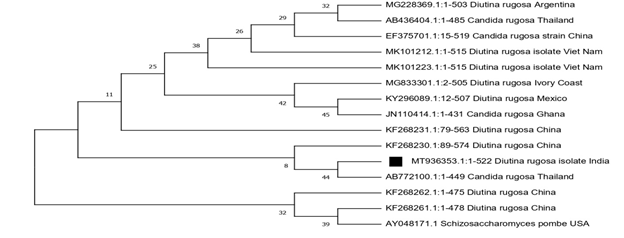Journal of
eISSN: 2373-437X


Short Communication Volume 11 Issue 2
Division of Animal Biotechnology, College of Biotechnology, Sardar Vallabhbhai Patel University of Agriculture & Technology (SVPUAT), India
Correspondence: Amit Kumar, Division of Animal Biotechnology, College of Biotechnology, Sardar Vallabhbhai Patel University of Agriculture & Technology (SVPUAT), Meerut-250110, India, Tel +91-9412120813
Received: March 03, 2023 | Published: March 21, 2023
Citation: Bhordia A, Kumar A, Upadhyay S, et al. First report of a yeast pathogen Diutina rugosa (syn. Candida rugosa) in an outbreak of mastitis in Holstein Friesian dairy heard in India. J Microbiol ExpM. 2023;11(2):43-44. DOI: 10.15406/jmen.2023.11.00384
Mastitis is one of the most prevalent causes of economic losses to dairy sector.1 It involves multiple etiological agents and that makes it difficult to cure.2,3 It is therefore, important to isolate, identify the causing agent for its earliest best effective treatment to avoid or to minimize losses.1 Accordingly, when a dairy, with 30 pure bred Holstein Friesian cattle, was reported with an outbreak of mastitis, the samples were received from local veterinarian to suggest the best possible antibiotic treatment but failed to control mastitis. The milk samples were submitted to than Department of Immunology & Defense Mechanism, College of Biotechnology, SVPUAT, Meerut for the isolation of bacterial pathogens and also to suggest suitable antibiotic treatment based on antibiotic sensitivity assay. None of the sample revealed bacterial growth. The fresh milk samples were collected from the untreated animals and cultured on different culture media including Potato Dextrose Agar (PDA).4 After 24 hours of incubation, PDA revealed some creamish white, round, smooth and raised colonies over the plate. Figure 1.
The staining of these colonies revealed the yeast like appearance on Gram staining. Figure 2
As the monoculture was obtained, it was subjected to DNA extraction and amplification of 26sRNA using ITS primer.5 The PCR revealed the presence of 500bp amplicons. Figure 3
The PCR products were outsourced to Biokart Pvt Ltd (India) for senger sequencing. The processing and BLAST of obtained sequences revealed Diutina rugosa (syn. Candida rugosa). The sequenced data has been submitted to NCBI database and assigned an accession number MT936353. The study for phylogeny linkage revealed Indian isolate of Diutina rugosa in close homology with the isolate of Thailand and both share a same route followed by the isolates of China, Ghana and Mexico. It reveals the ancestral linkage with Indian and Thai isolates. Figure 4

Figure 4 Phylogenetic tree showing the evolutionary relationship of the isolated species Diutina rugosa (marked with ) with the same species isolated from different countries.
Diutina rugosa (syn. Candida rugosa) are considered as “rare yeasts” and has been reported from different clinical conditions of animals. The drug susceptibility of isolates revealed susceptibility to azole compounds like fluconazole and less or no susceptibility to amphotericin B. Further, it is considered as an emerging fungal pathogen. A 10-year multi-center study reported 10 fold increase in the number of D. rugosa clinical cases.6 However, there is no such report of its involvement in lactating animals in India in available literature. Thus, it seems first report of an outbreak of mastitis due to Diutina rugosa (syn. Candida rugosa) from Indian subcontinent.
Ethical Approval: The ethical approval for the present study was obtained vide letter no. IAEC/ SVPUAT/2019/18 dated 25/07/2019 and CPCSEA, New Delhi vide letter no. V-11011(13)/2/2020 CPCSEA-DAFA dated 10/02/2020.
Authors declare no conflict of interest.
Authors are thankful the Director Research and Hon’ble Vice Chancellor, SVPUAT, Meerut for providing all the facilities required to conduct the study.

©2023 Bhordia, et al. This is an open access article distributed under the terms of the, which permits unrestricted use, distribution, and build upon your work non-commercially.